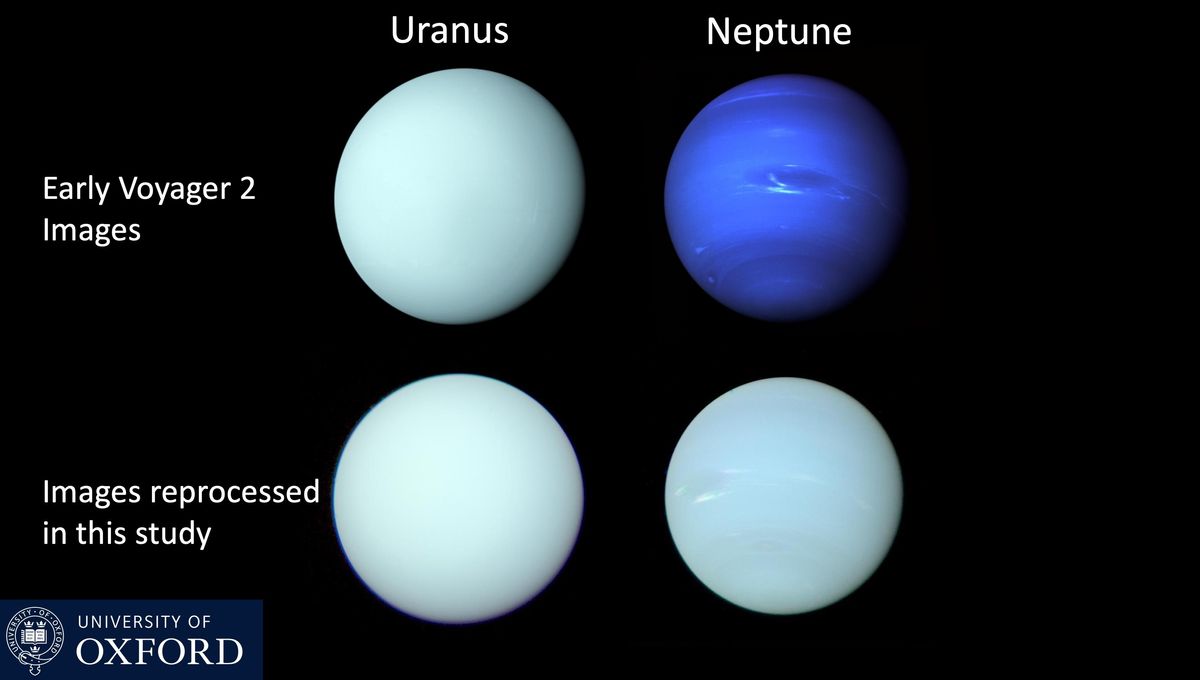
Uranus and Neptune are the ice giant planets of the Solar System and have plenty of similarities. A major difference at a glance has always been their color – sure, they were both on the blue spectrum, but the aquamarine Uranus was strikingly paler than the cobalt Neptune. It turns out that contrast was down to the processing of the image. To the naked eye, they wouldn’t look that different.
Researchers have reprocessed the Voyager images to match what our eyes would see. Cameras do not operate like our eyes. Imaging systems on telescopes and spacecraft have filters, and these can be used to highlight certain features more than others.
Voyager 2, the only spacecraft to ever fly past these two planets, took single-color images, and they were later reprocessed into what we have seen for the last few decades. Scientists knew that the processed Uranus and Neptune images were not their true colors. Hubble images of the two planets (also not true colors) show them much closer in hue than the Voyager 2 snaps. But creating a true-color image is not an obvious exercise.
“Although the familiar Voyager 2 images of Uranus were published in a form closer to ‘true’ colour, those of Neptune were, in fact, stretched and enhanced, and therefore made artificially too blue. Even though the artificially-saturated colour was known at the time amongst planetary scientists – and the images were released with captions explaining it – that distinction had become lost over time,” lead author Professor Patrick Irwin, from the University of Oxford, said in a statement.
“Applying our model to the original data, we have been able to reconstitute the most accurate representation yet of the colour of both Neptune and Uranus.”
It is thanks to observations from Hubble and the Multi Unit Spectroscopic Explorer (MUSE) on the European Southern Observatory’s Very Large Telescope that they were able to get to the true colors. The instruments collected the spectrum of the light from the planet and used it to make the Voyager images more faithful to our own seeing apparatus.
Neptune is a little bluer than Uranus due to a thinner haze. Uranus’s colors, meanwhile, change from greener to bluer during its peculiar seasons. The planet orbits roughly on its side following a major collision, so its seasons go from one pole facing the Sun, to the equatorial regions, to the other pole. At the solstices, when the Sun is over either pole, the planet is a little greener.
The team suggests that a haze of methane ice particles and a lack of methane at the pole could explain the difference in colors. Decades of observations show the subtle variations as the planet goes on its 84-year-long trek around the Sun.
“This is the first study to match a quantitative model to imaging data to explain why the colour of Uranus changes during its orbit,” Professor Irwin added. “In this way, we have demonstrated that Uranus is greener at the solstice due to the polar regions having reduced methane abundance but also an increased thickness of brightly scattering methane ice particles.”
Dr Heidi Hammel, of the Association of Universities for Research in Astronomy (AURA), who has spent decades studying Neptune and Uranus but was not involved in the study, said: “The misperception of Neptune’s colour, as well as the unusual colour changes of Uranus, have bedevilled us for decades. This comprehensive study should finally put both issues to rest.”
The study is published in the Monthly Notices of the Royal Astronomical Society.
Source Link: Thought Neptune Was A Different Color To Uranus? New Images Say Think Again